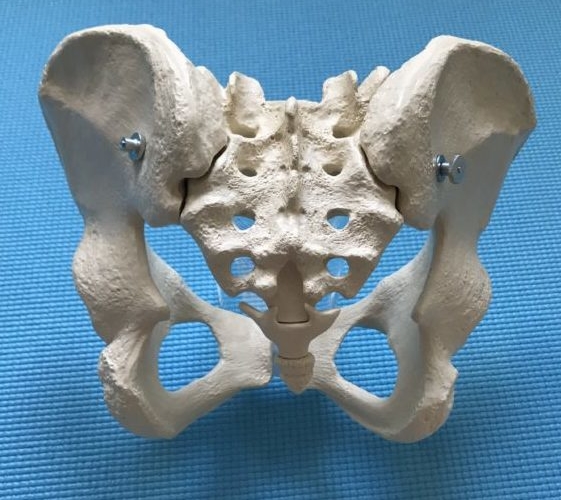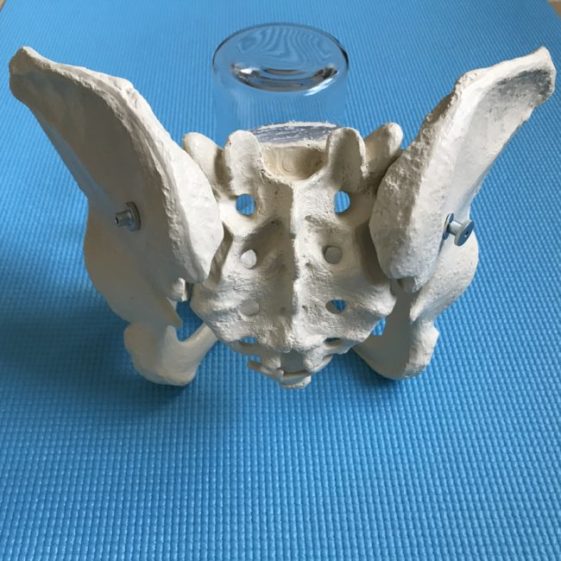What I learned the first time I held a pelvis in my hands

The first time I held a pelvis in my hands I was in Palo Alto, taking my first Spinefulness teacher training. I was also watching worlds collide.
My teacher, Jean Couch, brought out a model of a female pelvis, and put it in balanced posture, with the pubic bones facing the floor. The hip bones fit together snug and tight with the sacrum.
Then she tipped the front of the pelvis up, into modern posture. Gaps opened between the bones.
This anatomical fact is the key insight of Spinefulness.
Roll the pelvis into its natural forward position, and the spinal column has a stable foundation on the sacrum. Where they meet, the lowest spinal vertebra and the sacrum form our short, sharp natural arch. Once you have your natural arch, two things follow: a longer spine and profound relaxation.
Despite three decades of yoga classes in which I’d learned that sitting on “the ball points” of the sitting bones was the best way to lengthen my spine, I didn’t have a problem accepting this idea intellectually.
But then the pelvis made its way around the circle into my hands.
When I tipped it so the pubic bones rested on my thighs, I could see how the bumps and hollows on the hip bones made a tight fit with the hollows and bumps on the sacrum. When I held the pelvis in my familiar yogic sitting position, the joints between the sacrum and the hip bones gaped open, loose and unstable.

Like a bolt from the blue, I could visualize the bones of my own unstable, and intermittently twinging, right S.I. joint. It didn’t always hurt, but it hurt often enough that I’d created a special practice for when it flared. With the pelvis in my hands, the penny dropped. I was shocked to see a lasting solution to my nagging pain suddenly revealed. Even more shocking? I could see how much further forward my pelvis would have to rotate to come into balance.
I love skeletal models for exactly this reason: they make anatomy come alive.
But they can be expensive, and good ones are hard to find. So, I was delighted when, just a few weeks ago, I finally found a pelvis that was right for me, on the Osta International website (and no, I won’t make money if you buy something from them).
As soon as my pelvis arrived, I loosened the screws that held it together, so now it can respond to gravity. And in the interests of clarity, I also sawed off the two lumbar vertebrae that came attached. My pelvis is on the desk beside me as I write this, and I pick it up and look at it often. I also take it to class and pass it around when I teach. There’s no such thing as too many opportunities to know your bones, especially bones as important as these.
How important is the pelvis?
Think of it this way: in engineering terms, human beings are best described as bridges that walk. Our legs are the pillars, our pelvis is the arch that supports the weight of the upper body and transfers it into the legs. Every arch has a keystone. Ours is the sacrum. A loose keystone makes a weak arch. So, the way we place the pelvis determines the strength of our arch, and that helps determine the ease we feel in our body.
By the way, as dramatic as this bolt of understanding may be, it doesn’t mean that we should aim for sitting on the pubic bones right away. By standing with the pelvis forward, and sitting with it tucked, we’ve flattened our backs at the sacrum and introduced big curves in the lumbar. Our low back muscles have been in chronic tension for years. Go too fast, and you’ll bring on pain.
If you’ve been sitting on your tailbone, then sitting on your sitting bones is progress. If you sit on your sitting bones, take the weight slightly forward, onto the bones between the sitting bones and the pubic bones. In time, you’ll be more comfortable sitting forward, and you’ll wonder how you ever put up with the strain of sitting back.
Would you like a chance to hold a pelvis and see what it says to you?
Then come to a Spineful Yoga class, Sundays 10 am to noon, and Mondays, 5:30 to 7 pm.
Interested in seeing how Spineful alignment relates to yoga? Sign up for the Spineful Yoga Weekend Workshop, November 15, 16 and 17.